Travel does not exist without home....If we never return to the place we started, we would just be wandering, lost. Home is a reflecting surface, a place to measure our growth and enrich us after being infused with the outside world. - Josh Gates
11 October 2019, Tiébélé
Auberge Kunkolo 5,000XOF (R125)
Tiébélé comprises 67 villages, each with its own chief, housing a populace of over 100,000. It is presided over by a king with six wives whose family has reigned here since 1640. We came to visit the royal compound which used to house the king, now sensibly but less romantically moved into a concrete house outside the walls, and numerous family and extended family members. Around 350 people still live in the compound, but many houses are derelict, and some have fallen down just recently in the excess rains of this overlong rainy season. Unesco is eyeing the compound as worthy of being a World Heritage site.
Outside the compound wall is a small hill (a man-made mound), a place for animal sacrifice, and the court of justice. A drummer will climb the hill to call villagers to funerals, or major announcements, or celebrations, or court proceedings. The court sits on stones under a tree and it is here disputes are heard and resolved, in public.
Residents in the compound are mainly animist, but also Islamic or Catholic. Often believers in Allah or God, retain their animist beliefs and practices. There is a strong sense of “home”, and of symbolism and symbolic actions that ensure luck. After childbirth, for example, the placenta is placed in a pottery jar and buried, bringing good luck. No matter how far you travel, you will always be welcome where your placenta is buried.
The painted houses of Tiébélé are constructed from a mixture of mud and cow dung, making them susceptible to too much rain. They are patterned with designs representing, for example, chicken feet (the first sacrifice at ceremonies); arrow heads (black for those poisoned when fighting enemies, red for those used for hunting); fishing nets; cowrie shells; and more. Natural dyes are used: red being obtained from laterite, black from basalt, and white from kalk (chalk). Women are responsible for decorating the buildings. Once patterned, the paint is protected by a varnish created from boiling fruit in water (did not catch which fruit), painted in several layers.
There are different shape and size huts in each homestead for single men, for couples, for grandparents. There are smaller structures for goats and for the storage of millet and other dried products. Entrances were originally built low to the ground to protect families from enemies. Just beyond the door was constructed a low wall. Arrows aimed through the low door would hit the wall rather than the occupants, and anyone trying to enter, would be bent low, his head vulnerable to a blow from those taking shelter indoors. Windows were built into the flat roofs (not very practical in the rain as they are then covered and the room is dark). On the roofs, people can sleep in the hot months, and lay out corn and millet and other products to dry. Inside a well-kept home we saw floors and walls rubbed smooth, the walls carved with patterns. The ceilings are rough wood, branches spanning the uprights and holding the weight of the mud roofs.
Our guide, Aziz, who collected us at our hotel this morning and drove us on hs autocycle in two runs the 500m to the compound, told us that a boy had been killed this week in a collapsed home in one of the other villages, and that the crops were rotting in the fields. He also explained that traditional face scarring used to be a form of tribal identification; if done at all nowadays it is for decoration.
At breakfast this morning we were served honey with a “best before” date of 2017.
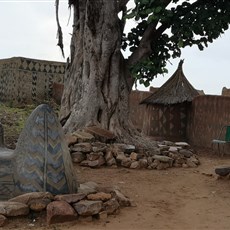
Tiébélé royal court - court of justice
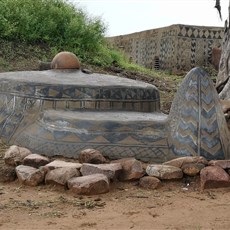
Tiébélé royal court - animal sacrifice space
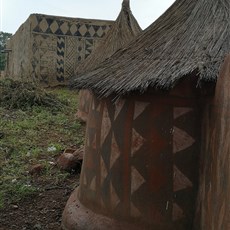
Tiébélé royal court
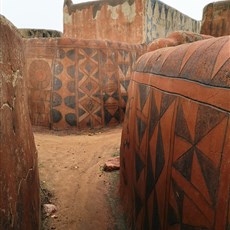
Tiébélé royal court

Tiébélé royal court
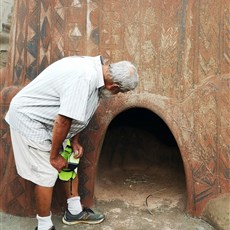
Tiébélé royal court - low doorway
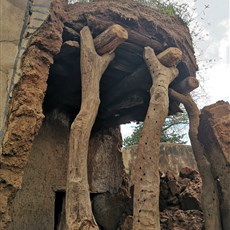
Tiébélé royal court - collapsed home showing roof construction
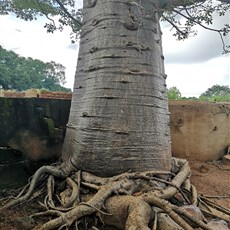
Tiébélé royal court
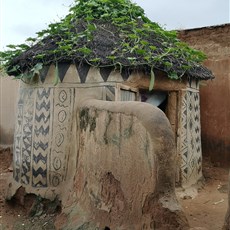
Tiébélé royal court
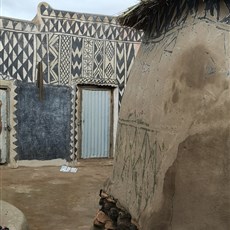
Tiébélé royal court - dry storage in foreground
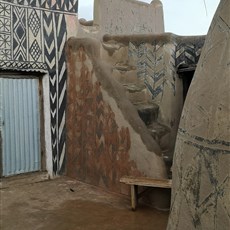
Tiébélé royal court - access to rooftop
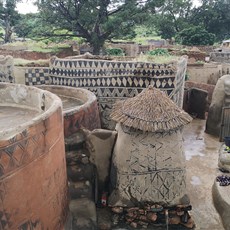
Tiébélé royal court
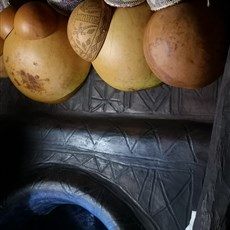
Tiébélé royal court - inside a home
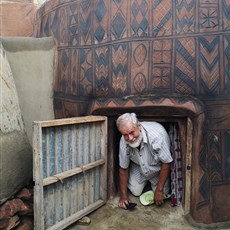
Tiébélé royal court - low doorway
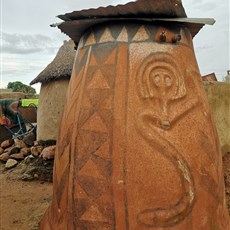
Tiébélé royal court